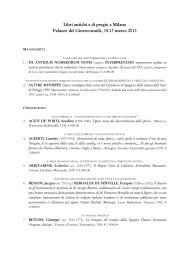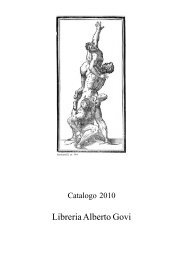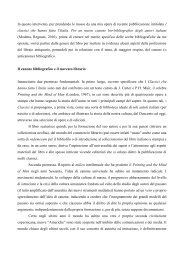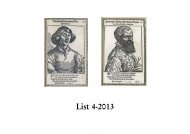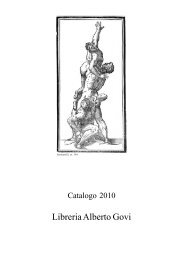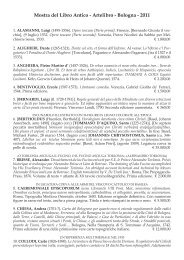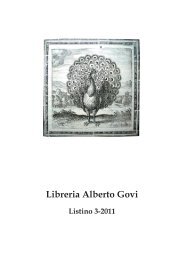the commercial success of the Venetian presses. With the death of his protector Farnese and the election of PopeGiulio III, Della Casa left Rome and, disappointed at not having been elevated to Cardinal, retired to a reflective lifeof writing and reading. It is during this period – sometime between 1551 and 1555 – that he conceived and draftedhis famous Galateo, in the Abbey of Nervesa near Treviso. This work was to become the most celebrated etiquettebook in European history. He died in 1556, probably in the Farnese palace in Rome, and is buried in the Church ofSant’Andrea in Rome. Della Casa is also remarkable as the leader of a reaction in lyric poetry against the universalimitation of Petrarch, and as the originator of a style, which, if less soft and elegant, was more nervous and majesticthan that which it replaced. Toward the end of his life, however, he followed the model of Petrarch, composingsome of the most intense lyrics of the sixteenth century. Published after the death of the poet in 1558, his Rimewould have a great success in literary circles of the time. His use of enjambment, a technique by which the elevensyllable line continues through to the next line, gave his verse a new musicality and power (cf. A. Santosuosso, Vitadi Giovanni della Casa, Rome, 1979, passim).Edit 16, CNCE 16463; Adams, C-812; Index Aureliensis, 132.790; L.D. Green & J.J. Murphy, Renaissance RhetoricShort Title Catalogue 1460-1700, (Aldershot, 2004), p. 161; A. Montador, Pour une histoire des traités de savoir-vivreitaliens, in: “Traités de savoir-vivre en Italie”, (Clermont-Ferrand, 1993), p. 314; A. Santosuosso, The Bibliography ofGiovanni della Casa, (Florence, 1979), p. 33, no. 20. € 1.800,00with the commentaries by Francesco Patrizi42) CONTILE, Luca (1505-1574) - PATRIZI, Francesco (1529-1597) - BORGHESI, Antonio (fl. 2 nd half ofthe 16 th century). Le rime di Luca Contile, divise in tre parti, con discorsi, et argomenti di Francesco Patritio, etM. Antonio Borghesi. Nuovamente stampate. Con le sei canzoni dette le sei Sorelle di Marte. Venezia, FrancescoSansovino et compagni, 1560.8vo; 18 th century vellum over boards, panels with double gilt fillet and gilt fleurons, spine with gilt ornaments andgilt title on red label, marbled end-leaves, gilt edges; (4), 108 leaves. With the printer’s device on the title-page. Avery fine copy from the library of Maruqise Mazzacara di Celenza.FIRST EDITION. The collection is divided into three parts. The first two are dedicated to Isabella Gonzagad’Avalos, marquess of Pescara; the third to Camilla Pallavicina. The first part, containing 50 sonnets and celebratingthe beauty of the famous Giovanna d’Aragona, were composed by Contile during his stay at Ischia in the entourageof Maria d’Aragona (cf. D. Chiomenti Vassalli, Giovanna d’Aragona fra baroni, principi e sovrani del Rinascimento,Milan, 1987, passim).The second part opens with another dedication (Ischia, November 23, 1547) to some of Contile’s Neapolitanfriends and contains 53 sonnets celebrating the Marquis del Vasto, Alfonso d’Avalos, to whom Contile wassecretary. The third part contains poems of miscellaneous arguments, among them some addressed to Contile.The six compositions Le sei sorelle di Marte, at the end ofthe collection, had already been published at Florencein 1556.The short commentaries to the second andthird parts are by Antonio Borghese, whereas the Discorsopreceding the first parts and the commentaries toit are by Francesco Patrizi, who Contile met in the AccademiaVeneziana (cf. L. Bolzoni, La ‘Poetica’ del Patrizi ela cultura veneta del primo Cinquecento, in: “L’Umanesimoin Istria”, V. Branca, ed., Florence, 1983, p. 26).“Metterà conto ricordare come nella raccoltadel Contile, commentata da Francesco Patrizi, sia dariconoscere il manifesto più esplicito, nel campo dellalirica volgare, della poetica sapienziale e platonizzantedell’Accademia Veneziana, cui appartenevano l’autore,il commentatore e il curatore Francesco Sansovino; e cheproprio la Parte prima delle Rime di Luca Contile, canzoniereencomiastico di cinquanta sonetti in lode di IsabellaGonzaga d’Avalos, costituisce il modello formaledella raccolta per Margherita di Valois (48 sonetti e duecanzoni) contenuta nel quarto libro delle Rime di BernardoTasso, antico sodale e corrispondente del poetasenese (ed alla stessa misura si informerà poi il canzonierein morte di Porzia, di 49 sonetti e una canzone, nelquinto libro delle Rime). L’eco del canzoniere filosoficodel Contile sarà per altro ben avvertibile in varie dellerime pubblicate da Torquato nella raccolta degli Eterei”(A. Casu, Sonetti “Fratelli”. Caro, Venier, Tasso, in: “Italique”,no. 3, 2001, pp. 45-87).Contile’s love poems are for Patrizi the only- 46 -
important ones along with those of Petraca and are meant “per rimettere in gioco alcuni dei nuclei discorsiviprestati dai neoplatonici fiorentini, da Pico e dalla trattatistica d’amore alla lirica del primo Cinquecento, e un’occasioneper prendere le distanze dalla linea maestra del Classicismo bembiano, che, degenerata ormai nella sperimentazione‘artificiosa’, con l’esaltazione esasperata del sistema dell’elocutio, con la depressione pressoché totaledell’inventio, con la dissociazione delle parole dalle cose, il discorso amoroso ha finito per svuotare di senso preferendogli‘altro’. Scelti espressamente per il loro primum contenutistico […], i cinquanta sonetti del poeta seneseche due anni più tardi diventerà interlocutore privilegiato del V dialogo della Historia [Il Contile overo della veritàdell’Historia], innescano infatti nelle pagine patriziane un pesante lavoro di demolizione non soltanto della tradizionelirica greco-latina improntata allo stesso soggetto, ma anche di quella italiana, censurata del tutto e rimossa […]Due gli obiettivi dichiarati nello scritto, incentrato sulla querelle Antichi-Moderni e significativamente polarizzatointorno al binomio dottrina-eloquenza che tanta parte aveva avuto e continuava ad avere nelle Accademie venetedel tempo, dalla compagine Infiammata a quella della Fama: mettere a confronto la povertà concettuale dei Greci edei Latini in materia d’amore e il bagaglio dottrinale degli Italiani, sui quali tutti accampare i magisteri inarrivabilidi Petrarca e Contile; contrapporre paradigmaticamente le risorse logico-argomentative dei più accreditati maestridel dire presenti e passati, i loro artifici verbali, il loro sapere tecnico, alla sapienza retorica naturaliter inscritta nellinguaggio; rivelare le segrete vitalità di quest’ultimo, le sue intrinseche capacità di accrescere, vitalizzare e potenziare,in poesia come in qualsiasi altro ambito discorsivo, la forza significante delle parole” (L. Borsetto, “Concetti daporre in amorosa poesia”. L’accessus neoplatonico di Patrizi alle ‘Rime’ di Luca Contile, in: “Riscrivere gli antichi, riscriverei moderni”, Alessandria, 2002, pp. 305-307).“In un personaggio così notevole come è il Patrizi un piccolo episodio come quello del suo commento alContile può apparire laterale, se si isola dal contesto di tensione spirituale ed intellettuale in cui è immerso: ma senon si perde la prospettiva di tale tensione, e se si considera che esso è una tappa del cammino del Patrizi tra il Discorsodella diversità dei furori poetici (1553) e la Poetica (1586), e per di più tappa di uno scoperto impegno di giudiziosu fatti letterari, risulterà non trascurabile nella sua vicenda culturale” (R. Scrivano, Luca Contile e Francesco Patrizi,in: Id., “Cultura e letteratura del Cinquecento”, Rome, 1966, pp. 191-192).Luca Contile was born in Cetona in Val di Chiana and studied at Siena and Bologna. He then entered theservices of Cardinal Agostino Trivulzio at Rome and moved to Milan as secretary to Alfonso d’Avalos, marquisof Vasto. During this period he became friends with Pietro Aretino, Paolo Giovio, and Giulio Camillo. After Alfonso’sdeath in 1546, his widow, Maria d’Aragona, moved her court to Naples and Contile followed her. In 1548he returned to Milan working for Don Ferrante Gonzaga. Beetwen 1552 and 1557 he is found in the entourage ofCardinal Cristoforo Madruzzo. Shortly afterwards he settled in Venice as secretary to Sforza Pallavicino and herehe was on friendly terms with Francesco Patrizi, Girolamo Ruscelli, and Lodovico Dolce. In 1562 he found a homein Pavia, participating to the activities of the Accademia degli Affidati, under the name of ‘Il Guidato’. Contile wasthe author of comedies (Pescara, Cesarea, Trinozia) and allegirical eclogues (Agia, Nice), published two volumes ofcorrespondence (1564), the Dialoghi spirituali (1543) inspired by Vittoria Colonna, and an important work on emblems(1574) (cf. Abd-el-Kader Salza, Luca Contile. Uomo di lettere e di negozi del secolo XVI, Rome, 2007, pp. 1-102).Francesco Patrizi (Frane Petrić) was born on the island of Cres (Cherso, Croatia), the son of the townjudge Franjo and Marija Lupetina, a cousin of Matthias Flacius Illyricus. Franjo was accused of subversive activitiesagainst the Venetian authorities and of supporting the Protestants. He was sentenced to banishment and died inexile. Francesco used his heritage to finance his studies, although, as the son of a banned heretic, he had to litigateover it for most of his life. After studying in his native city with Petruccio da Bologna, he quit school and left theisland of Cres in 1538 as a crew member on his uncle’s ship. At that moment began the tumultuous period of hislife. He went on many voyages (he served in the Venetian navy under the command of Andrea Doria and wentin combat near Novigrad) and changed many jobs (e.g. book and cotton trade, publishing). Subsequently he wentto trade school in Venice and studied grammar under Andrea Fiorentini, a proof reader fort the Giunti press. AsFlacius’ protégé he went to Ingolstadt to study Greek and in 1547 to study medicine at Padua, but soon changed tophilosophy and mathematics. After his father’s death in 1551 he went to Ancona, made some short trips to Venice(where he became a member of the Accademia della Fama), to Bologna, Verona, Vicenza, Mantova, Modena andFerrara. In 1553 appeared his first work in print, a collection of essays containing also his important utopia, La Cittàfelice. He settled for a while on Cyprus, where he worked as supervisor of the estates of Count Contarini Zaffo andFilippo Mocenigo, archbishop of Cyprus. He later travelled to Spain and sold a collection of seventy-five importantGreek codices to the Spanish King Philip II for his Escorial library. Afterwards he obtained the chair of philosophyat Padua, where he taught until 1592, when Cardinal Ippolito Aldobrandini asked him to come to Rome and teachPlatonic philosophy at the Sapienza. In Rome he became a member of the Council of St. Jerome, at the Illyrian Collegeof St. Jerome. Patrizi died inthe Eternal City and was buried in the church of Sant’Onofrio, in the tomb of hiscolleague Torquato Tasso. His fame, however, rests on his most significant philosophical work, Nova de UniversisPhilosophia (1591), which was too written to combat Aristotelianism and Scholasticism and to affirm Platonism inall its fullness. When it was published, it was hailed as the work of a genius but was condemned by the Church (cf.C. Vasoli, Francesco Patrizi da Cherso, Rome, 1989, passim).Adams, C-2589; Edit16, CNCE13182; Salza, op. cit., p. 277, no. 12a. € 1.650,00- 47 -
- Page 1 and 2: Catalogue 2013Libreria Alberto Govi
- Page 3 and 4: Catalogue 2013Libreria Alberto Govi
- Page 5 and 6: an hitherto unknown philosophical m
- Page 7 and 8: ustica Lib. X., edited by Giorgio M
- Page 9 and 10: the end is furthermore printed the
- Page 11 and 12: without typographical data, but pro
- Page 13 and 14: Letteratura Italiana”, CXL, 1963,
- Page 15 and 16: as secondary only.The present two e
- Page 17 and 18: position as secretary at the court
- Page 19 and 20: From 1528 he was rector of the newl
- Page 21 and 22: famous personage was in high favor
- Page 23 and 24: Luigi Alamanni and Antonio Brucioli
- Page 25 and 26: In Pincio’s biography of Bernardo
- Page 27 and 28: Tempio della Fama; e così ne trass
- Page 29 and 30: power, and yet to make it possible
- Page 31 and 32: lini, Andrea Alciati, Lilio Gregori
- Page 33 and 34: phy in particular, was presented as
- Page 35 and 36: quale quello che lui auspicava, e l
- Page 37 and 38: After the flight of the Medici from
- Page 39 and 40: to learn from their own experience
- Page 41 and 42: with some manuscript compositions p
- Page 43 and 44: death sentence issued against him o
- Page 45: the key work to Della Casa’s thou
- Page 49 and 50: a heavily annotated copy44) HORATIU
- Page 51 and 52: solitudine (1545), but undoubtedly
- Page 53 and 54: provide less description of patholo
- Page 55 and 56: the most up-to-date scientific ency
- Page 57 and 58: (pp. 4-10) written by the author hi
- Page 59 and 60: successivi alla consapevolezza che
- Page 61 and 62: night [February 22]. Rarely does a
- Page 63 and 64: subjects, including Saint-Gelais’
- Page 65 and 66: Catherine de’ Medici, succeeded o
- Page 67 and 68: losofico ed allegorico delle Metamo
- Page 69 and 70: The act concerning primogeniture is
- Page 71 and 72: are not many in number but who are
- Page 73 and 74: the Camilletta, his first work, Gut
- Page 75 and 76: selig, sich nit allein zu kunst geg
- Page 77 and 78: dle, or low. There are, however, pr
- Page 79 and 80: nity: ‘mercenaries should be done
- Page 81 and 82: colò Sfondrati), to whom the Causa
- Page 83 and 84: close of Semiramis’ career. Ninus
- Page 85 and 86: e contenuti matematici in Henri de
- Page 87 and 88: The first Hungarian dictionary - Cr
- Page 89 and 90: & T. Kovács, Deutschlernen in den
- Page 91 and 92: chitectura’ des Wenzel Dietterlin
- Page 93 and 94: neo-Latin anthology devoted exclusi
- Page 95 and 96: as De la puissance ecclésiastique
- Page 97 and 98:
colazione was not eaten first thing
- Page 99 and 100:
advanced both the technical and the
- Page 101 and 102:
di Giorgio Zorzi, ambasciatore in O
- Page 103 and 104:
the Misnah100) MISNAYOT MESUDAR NAS
- Page 105 and 106:
the task of taking part to the nego
- Page 107 and 108:
This is the only iconological work
- Page 109 and 110:
on that occasion, were described an
- Page 111 and 112:
millo Camilliani, Francesco’s son
- Page 113 and 114:
Blanchard, Correggio and Mignard, R
- Page 115 and 116:
di Cicerone d’ottime antiche stam
- Page 117 and 118:
Pietro Aretino125) MAZZUCHELLI, Gio
- Page 119 and 120:
music129) TESTORI, Carlo Giovanni (
- Page 121 and 122:
Vol. VIII (1773): pp. (6), 854 with
- Page 123 and 124:
Di Felice e Gregorio Fontana, 1905,
- Page 125 and 126:
Cicognara, no. 190 (“Nelle quattr
- Page 127 and 128:
mo: fonti, theorie, modelli, 1750-1
- Page 129 and 130:
commentary on the treaty on shabbat
- Page 131 and 132:
poet laureate of Austria, and he le
- Page 133 and 134:
geo-political situation of the regi
- Page 135 and 136:
ope collecting views and pictures o
- Page 137 and 138:
inc.), 100 numbered engraved plates
- Page 139 and 140:
a gift from Emperor Napoléon III t
- Page 141 and 142:
Ardène, no. 123Caprara, no. 103 Tr
- Page 143 and 144:
Speckle, no. 73 Besson, no. 60- 143



